2000 Porsche 996 911 Evomsit Software Upgrade Reviews
Porsche 911 Common Problems
Smoke at Start-Upward or Cheque Engine Light, etc?
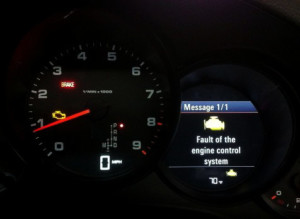 Listed below are Porsche 911 common mechanical issues with their likely resolutions. These are the most frequent 911 problems diagnosed past our repair shops over the years.
Listed below are Porsche 911 common mechanical issues with their likely resolutions. These are the most frequent 911 problems diagnosed past our repair shops over the years.
An accurate diagnosis of an issue by a Porsche mechanic typically saves you fourth dimension and money – see our guide to local independent Porsche repair shops that can help. If y'all're researching and because buying a 911, our used motorcar buyer guides highlight mechanical problems to be aware of earlier y'all complete a purchase.
Check engine light? Scanned the motorcar and non sure what to make of those OBD codes? Our article on how to interpret and make sense of those error codes may help.
Maintenance rarely solves a problem. All the same, neglecting maintenance tin cause problems – check your last service update with our recommended maintenance schedules.
Scanned Your 911 and Read Diagnostic Codes?
The following sections place common problems through symptoms. If yous take scanned your Porsche OBD2 organization and have identified fault codes, get to our Porsche powertrain mistake lawmaking page to get fault descriptions.
Tin't Observe An Respond Beneath? – Contact Us For More Help
If your 911 has mechanical issues that don't appear here, but drop us an email via the forms or popular-up contact and we'll do our best to share a solution with you.
Clicking on a heading gives yous more detail.
996 | 997 | 991
Mutual Oil Leaks
Porsche vehicles accept a number of regular sources for leaking oil. Some of the most common include rear main seal (run into below), valve covers, spark plug seals and turbo oil supply line seals. Less common are leaks from the cam seals and scavenger oil pump seals.
Symptom : Oil Drips On Floor Backside Rear Wheels
 Valve embrace leaks are obvious and fairly straightforward to fix on most models. The valve covers do not have a gasket – instead a liquid gasket sealer is used. The time consuming part is removing the onetime gasket sealer from the valve cover to ensure a proficient seal for the replacement.
Valve embrace leaks are obvious and fairly straightforward to fix on most models. The valve covers do not have a gasket – instead a liquid gasket sealer is used. The time consuming part is removing the onetime gasket sealer from the valve cover to ensure a proficient seal for the replacement.
Symptom : Misfires CEL or Oily Spark Plugs
Spark plug tube seals are also prone to leaking – leaks from the spark plug tube seals tin can be frustrating. Often, you wont meet the oil initially as it's sealed in past the coil on height of the spark plug. The tube fills with oil and causes misfires by destroying the plug and the ringlet. If you lot meet oil on a plug or curlicue, e'er supersede the seals.
The early engines had a plastic tube insert and the afterwards engine features two seals. The upper seal can be replaced when removing the valve cover. The lower seal leaking is more of an issue and requires removal of the camshafts.
Rear Main Seal Oil Leak
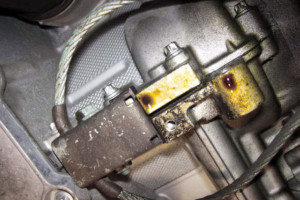 Symptom : Oil Leak Betwixt Engine & Transmission
Symptom : Oil Leak Betwixt Engine & Transmission
One of the near common, misunderstood and potentially subversive issues is an oil leak from the rear master seal on the Porsche engine. A leaking rear master seal appears through the bell housing joint between the center of the engine and manual articulation. The leaking seal volition quickly destroy a clutch in a manual car if not addressed promptly.
Some circumspection – vehicles that are stored often display a weep/leak from the seal during storage or at the initial startup in the bound. The seal needs the heat of driving to remain sealed efficiently, so in some circumstances the leak can slowdown or cease during the driving flavour. Replacing the seal requires the removal of the manual and in a manual car, replacement of the clutch at the aforementioned time is a good selection.
The seal does dry over fourth dimension and can leak, however, at that place are other potential bug that could besides cause the seal to leak (see Air Oil Separator below). Causes of the seal failure should be checked thoroughly past a competent shop earlier yous keep to supplant the seal.
Air Oil Separator (AOS)
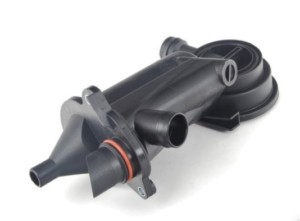
Symptoms : Fume From Exhaust, Oil In Intake, Rear Principal Seal Leak
Bad rear main seal or something else causing the problem?
As an integral part of the emissions system, the Air Oil Separator (AOS) is designed to extract oil from gases in the crankcase. The oil is recycled to the sump and the gas is sent through the combustion path to be burnt and cleaned by the catalytic converters. The AOS has caused numerous bug on Porsche engines.
As the membrane in the AOS fails, oil is sucked into the air intake. Initially this tin show up equally a check engine calorie-free for fuel adaptations and the oil can be deposited on the o2 sensors causing emission faults.
Of form, one time information technology fails completely, the resultant huge clouds of white smoke are fairly obvious. At that point, information technology is clear what needs to exist washed. Even so, replacing the aos sooner rather than later can be a good precaution against other failures.
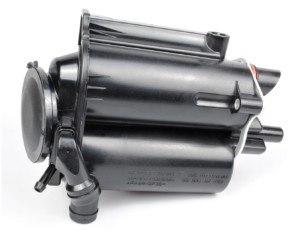 A failing air oil separator (aos) is the likely cause of rear main seal failure and oil leaks, as it is in other VAG cars. Crankcase vacuum exceeds the normal range in the engine under heavy acceleration and sucks in air damaging the rear main seal. This is commonly seen on Audi engines as well.
A failing air oil separator (aos) is the likely cause of rear main seal failure and oil leaks, as it is in other VAG cars. Crankcase vacuum exceeds the normal range in the engine under heavy acceleration and sucks in air damaging the rear main seal. This is commonly seen on Audi engines as well.
A failing aos also causes besides much oil to pass into the intake and volition force the engine direction to adjust fuel mixtures to compensate. The changing mixture can crusade over fueling and pb to other more pregnant problems – Meet smoke at startup below.
For cars that go to the track on a regular basis, a Porsche Motorsport AOS upgrade is highly recommended. The upgraded aos features a doubling in size of capacity for scavenging and is less prone to sucking upward oil during loftier speed cornering.
Smoke on Startup - Cold Engine
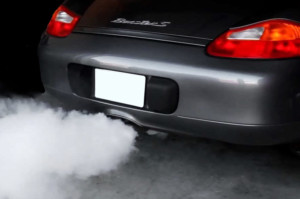 Symptom – Puff of Fume at Cold Kickoff
Symptom – Puff of Fume at Cold Kickoff
A quick puff of fume equally you start a cold engine is non uncommon, especially on the Porsche flat six engine. There are many theories and diverse thoughts equally to why this happens – none are proven. What we practice know is that re-built engines rarely display this startup smoke, so it's definitely a sign of clothing and tear – and information technology does progressively get worse with mileage. Vehicles that have sat for a while, such as winter storage, frequently blow more smoke at their first commencement than subsequent ones.
Extended smoking at startup is more of an consequence. Again, there could be a number of reasons why this happens, but it is usually a sign of vesture in the cylinders. See cylinder scoring below.
Sometimes, replacing the fuel injectors tin can help this problem. Worn and leaking fuel injectors crusade fuel to sit in the intake path while the automobile is parked. The fuel leaking is not enough to cause starting problems, but it can exist responsible for the fume and vesture in the cylinders – the excessive fuel heading into the cylinders washes oil off the cylinder walls causing wear on the piston rings and liners.
The fume at startup can also be caused by a air oil separator (AOS) that is going bad only not completely failed yet.
Cylinder Scoring – The Deadly Knocking Racket
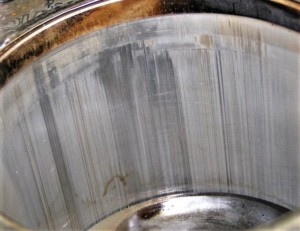 Symptoms – Knocking Dissonance, Oil Consumption
Symptoms – Knocking Dissonance, Oil Consumption
The M96 and M97 engines are famed for cylinder scoring – deep gauges in the cylinder liner, usually associated with a knocking noise and eventually catastrophic engine failure. The root crusade of this upshot is open up to discussion, however, wear in the piston rings and liners causes the piston to wobble. The wobble occurs at the bottom of the stroke and results in the piston brim dragging against the cylinder wall thereby scoring the liner.
More recently, this issue has also been seen on the later engines. An early telltale sign tin often be 1 exhaust tailpipe being more sooty blackness than the other.
The audio of this trouble is not a tick like a bad lifter, it's more a rhythmic knock and usually shows up first on the passenger bank of the apartment half dozen engines. Wearable in the piston rings and the liners of the cylinder take caused the piston to wobble. The wobble occurs at the bottom of the stroke and causes the piston skirt to drag against the cylinder wall causing scoring of the liner. The rhythmic knock is the piston changing position at the lesser of the stroke and striking the liner. In many cases, even with the caput off the engine, the worst scoring cannot exist seen until the piston is removed – it can be way downwards at the bottom of the cylinder.
The only solution here is a replacement engine or rebuild and re-lining of the cylinders. A competent Porsche repair shop tin help you lot through this process. Results from this tin be fun – nosotros made 425HP from a four.0L engine rebuilt from a broken 3.6L – all the same, you're going to need a $25K budget to start the projection!
IMS Bearing – The Hype vs The Facts
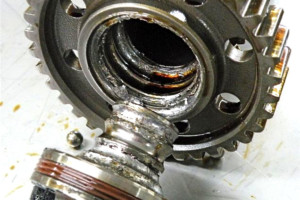 Symptoms : Metallic Shavings In Oil
Symptoms : Metallic Shavings In Oil
M96 engines fitted to the 996 and early 997 tin can have issues with a bearing at one end of the intermediate shaft. The shaft connects the 2 ends of the engine timing gear. At one finish the shaft drives the oil pump and at the other, finishes in a sealed begetting.
There's no dubiousness that a cheap sealed bearing of the kind that sits at the terminate of the intermediate shaft on an M96, has no place in a performance engine. Porsche afterwards redesigned the engine to eliminate an IMS bearing later clearly identifying its potential for weakness.
Nonetheless, the hype generated by people who have to proceeds from identifying the problem with this bearing and the real globe results don't quite friction match.
Yes, be articulate, the IMS bearing is a weak point and it will neglect. However, in the existent globe less than 5% take actually failed or can exist directly linked to an engine failure. Porsche shipped approx. 77,000 vehicles to the USA that could take a bad IMS bearing. Even the near enthusiastic counting of IMS failures produces a total around 3500 or less than 5%. This means there are more than 73,000 vehicles out there that haven't had the problem yet or take been retrofit with a newer bearing. Of form, that number excludes the cars driven into a ditch, wrapped around a lamp mail, rolled off a cliff or prepare burn down too, but you get the point. There are significantly more practiced M96 engines than bad ones.
Most competent shops will recommend replacing the begetting at least as a safe baby-sit against a future failure.
Low or No Bombardment Power
 Symptoms : No Crank or Slow Crank
Symptoms : No Crank or Slow Crank
Porsche 911s are oft garage queens and non driven as much every bit many other cars – rarely are they daily drivers. During any downwards period the auto will continue to use some battery ability – in Porsche's instance, normally more than than would exist expected from like vehicles. This can very speedily pb to a apartment bombardment.
Losing battery power resets a number of important systems and tin can cause unnecessary headaches with everything from emissions to electronics and comfort items such as cabrio roofs. Nosotros recommend you use a battery maintainer whatsoever time you store or practice not drive the auto for an extended menses – two weeks or more. Leaving the battery to bleed completely unremarkably shortens the life of the battery every bit well.
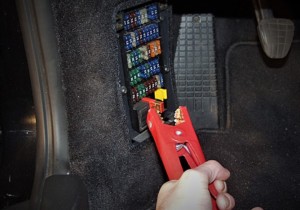
A flat bombardment on a 911 can be a hurting. To access the battery or engine compartment requires battery power for the electrical hood release – not easy with a flat battery. If this happens, employ the following procedure:
- Open the left door
- Connect an external battery power source to fuse C3 in the interior fuse panel
- With the door open, flip the door latch mechanism to the closed position
- Apply the key to lock and unlock the door
- The front end hood release should at present office
Bank check Engine Light - Engine Runs Commonly
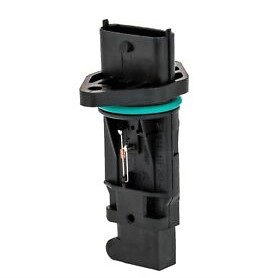 Symptoms : CEL Engine Runs Well
Symptoms : CEL Engine Runs Well
There are many potential causes of a Check Engine Light on Porsche 911 vehicles and it's important to read the codes or have a repair shop do that for you lot to assess the faults.
1 of the nearly common causes for a CEL on the older M96 engine is a failure in the O2 sensor and mass airflow systems (MAF). Normally, the MAF begins to fail and delivers the engine management with inaccurate information regarding the menstruum of air into the intake.
This causes the engine management to adjust fuel mixtures using a gear up of parameters which were likely set also broadly past Porsche initially. The resultant adjustments cause the front end O2 sensors to report faults and often pb to them failing completely. The fault codes will suggest faulty O2 sensors. This results in many folks replacing the forepart O2 sensors in the hopes of solving the problem, just to discover that within a few hundred miles the check engine light is back on.
The problem is really caused by the MAF failing and by owners blindly believing the reported engine faults. The faults are an indication of the symptoms and not the route cause. The recommended solution is to replace both the MAF and front O2 sensors at the same fourth dimension. Ever utilise the original Porsche parts – the aftermarket versions practise non piece of work. Cleaning the MAF rarely fixes this problem.
Check Engine Calorie-free with Misfires - Engine Runs Rough
Symptoms : Engine Runs Crude or Lacks Power – Flashing CEL
Misfires tin occur at whatever time and require diagnosis to identify which cylinders are misfiring and why. Mutual causes are worn spark plugs, cracks in ignition coils and oil leaking past the spark plug tube seals.
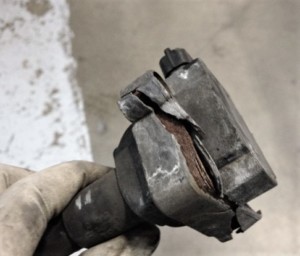 The ignition coils on the M96 and M97 engines accept been updated multiple times. The original coils were prone to peachy and were replaced past a more substantial version. Low mileage older cars will unremarkably still have the older style coils and it's best exercise to supervene upon them all to the newer version even if merely a single coil has failed.
The ignition coils on the M96 and M97 engines accept been updated multiple times. The original coils were prone to peachy and were replaced past a more substantial version. Low mileage older cars will unremarkably still have the older style coils and it's best exercise to supervene upon them all to the newer version even if merely a single coil has failed.
Fuel injector malfunction can crusade a misfire, all the same injector failure of this nature is not so mutual on the Porsche flat vi engines. More than common is a failure in the wire or plug connected to the injector. These wires become brittle and can scissure, peculiarly when being moved around for routine maintenance.
Over-heating – Cracked Cylinder Liner
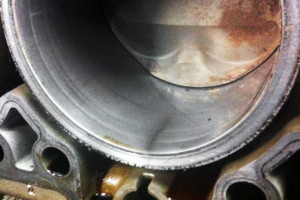 Symptoms : Engine Overheats and Loss of Coolant
Symptoms : Engine Overheats and Loss of Coolant
Each cylinder bore in the engine case one-half of the M96 and M97 are lined with a ane-piece sleeve or liner. A crack in the cylinder liner of the engine tin show upward in a number of ways from overheating, loss of pinch to oil consumption. Often, the problem is not simple to diagnose because the cracks can have a long running flow earlier they starting time to work their magic.
Here's a first manus case. Customer tows a 997 to us. A coolant hose had exploded – one of the main pipes leading to the front radiators. Customers says the automobile didn't over-heat, the hose just exploded. We replaced the hose, refilled the coolant, exam drove the auto for 30 mins – everything was perfect.
The customer calls the day after picking upward the car and driving 1-hour to get dwelling house – the machine flashes depression coolant light and we establish that all the coolant has disappeared from the reservoir. Of grade, customer blames us for not putting enough coolant in the engine and with the customer e'er being right, the car is towed back at our expense.
We scanned the car – no overheating and no faults or events were recorded. We know we filled the coolant to the correct level initially and so, we refilled the coolant, ran the engine and collection the car – it's perfect. Where did that coolant go?
Suspicious of a cracked liner, we decided to let the engine run at idle while we ate lunch. The engine ran perfectly at a steady temperature for approx. 55 mins. Then suddenly, it chop-chop started to get hot, a coolant called-for smell appeared in the exhaust and the coolant level started to drop quickly. In one case it had cooled downwards, we could repeat this perfectly – every 55 mins of running and it would overheat and consume the coolant.
Long story shortened – in one case nosotros had dissembled the engine, we found a series of micro fractures in the cylinder linings. It took nigh an 60 minutes of running for these cracks to open plenty for the engine to start consuming the coolant. The engine required a full rebuild and liner replacement to solve the problem.
Clutch Pedal is Heavy - Turbo 911
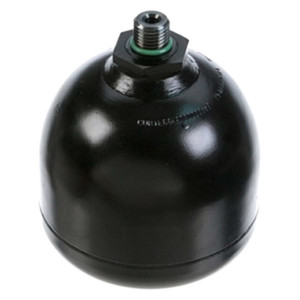 Symptoms : Pre-Offset Clutch Pedal Difficult To Push Down
Symptoms : Pre-Offset Clutch Pedal Difficult To Push Down
This is a common problem on before 911 Turbos with manual transmissions.
If y'all experience a very heavy clutch pedal before you start the engine, the common and probable cause is the pressure level accumulator. This is a device designed to retain the hydraulic pressure level necessary to operate the clutch subsequently the engine has been stopped. In many circumstances the device will begin to leak the pressure dorsum into the system and non part when called upon prior to startup.
Information technology is common practice to replace the clutch slave cylinder at the same time as replacing the pressure level accumulator. The slave cylinder is often damaged or at to the lowest degree has its expected life shortened after the accumulator has failed.
Coolant Leaks - Leaking Radiators, Hoses and Water Pumps
Symptoms : Depression Coolant Low-cal On or Flashing
In general, the Porsche 911 cars are pretty reliable for their cooling systems. At that place are nevertheless, a number of weaker areas that can sometimes crusade issues.
Coolant Reservoir Leaks
One of the most frustrating leaks is a small crevice in the coolant reservoir. This happens on all models and normally shows upwardly equally a coolant odour while driving with minor loss of coolant over a period of time. Somewhen a pocket-size crack will carve up wide open up and empty the reservoir rapidly – this is to be avoided if at all possible. Replacing the reservoirs on 911 models is not expensive just can be a pain – look at the location of the reservoir in the 911 engine bay and notice you lot demand to extract a fairly large object through a very small space!
You should never loose coolant while driving – so if your coolant level does decline over time, observe the cause and solve information technology asap. Under worst circumstances this could be a sign of a cracked cylinder liner.
Radiators
 On the 911 in particular, the radiators are low down and exposed to incoming route debris. Small holes in the radiator can be difficult to run across without removing the forepart bumper and searching for the telltale white coolant stain. Often the holes are not acquired by debris hitting the radiator simply are due to deterioration of the seals in the corners of the radiators.
On the 911 in particular, the radiators are low down and exposed to incoming route debris. Small holes in the radiator can be difficult to run across without removing the forepart bumper and searching for the telltale white coolant stain. Often the holes are not acquired by debris hitting the radiator simply are due to deterioration of the seals in the corners of the radiators.
Leaf and road droppings is not hands cleaned out from the depths beneath the bumper and can concord moisture against the radiator causing metallic corrosion. We recommend cleaning the radiator areas regularly or adding aftermarket screens to the front of the openings to reduce the problem.
Hose Connectors
The newer models have the push-click-lock type of hose connector – no clamps. These are easy to become on and off only accept a nasty addiction of becoming former use if non removed carefully. If yous have to remove a hose with this type of connector ensure that when replaced it does not leak under farthermost force per unit area. Of course, if it does, you need to replace the complete hose and not just the connector.
H2o Pump Failure
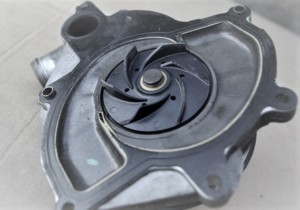 Water pumps fail regularly. This is non news, but some solutions accept been over hyped.
Water pumps fail regularly. This is non news, but some solutions accept been over hyped.
The bearing in the water pump supporting the shaft wears and the shaft starts to wobble. This develops into a knocking noise sometimes accompanied by a coolant leak. The plastic impeller can degrade rapidly and spread menses-blocking plastic throughout the cooling system. Getting plastic debris out of the forepart radiators is difficult and time consuming.
The water pump is elementary to reach under the car and checking the corporeality of play on the pulley is relatively elementary. With the engine running, observe the pulley and see if there is any sign of wobble.
The hype – get rid of the original plastic impeller pump and put in a h2o pump with a metal impeller. This seems like a solid idea, right upward to the point where the bearing fails again. At present the metal impeller volition wobble and score the within of the cylinder block causing permanent damage. In some cases, the damage is so severe that the case half would demand to be replaced. Additionally, metal flakes are now floating around the coolant system.
We recommend sticking with the plastic impeller and inspecting the pump on a regular ground. It's easy to see when the engine is running and you but take to sentry for wobble. If in doubt, the work to replace it is quite simple and should be considered a 40K or 4 year particular of preventative maintenance.
Oil Mixed in Coolant System or Coolant in Oil
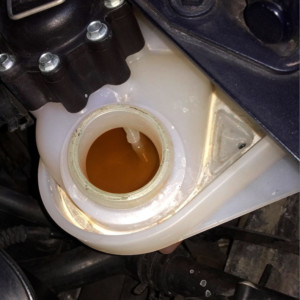 Symptoms : Oil Residue in Coolant Reservoir – Peanut Butter!
Symptoms : Oil Residue in Coolant Reservoir – Peanut Butter!
Nether the worst circumstances, oil in the coolant can wait like peanut butter in the coolant reservoir. It typically starts out as an oily movie and continues to get worse over time. There are many potential problems associated with this sign – oil could exist getting in to the coolant from a blown head gasket, from a cleft in the cylinder head, a fissure in a cylinder liner or the oil cooler. For sure, coolant in the oil and visa versa is a bad sign, the question is how lucky will y'all exist as to where the problem is? Diagnosing the problem often requires multiple steps.
The simplest place to start is by replacing the oil cooler – this is the easiest and least expensive detail to tick off the list of possible problems. Mostly the likely effect is acquired by the coolant and oil swapping places through the oil cooler.
Bold the the oil cooler is the effect, it sits beneath the intake and is exchanging heat between oil and coolant at a barrier level. When the bulwark separating the ii fluids inside the cooler breaks down, fluid can be exchanged – sometimes in both directions. The issue is oil in the coolant and worse, coolant in the oil. Coolant in the oil is a quick manner to needing a new engine, then it's disquisitional to diagnose this problem asap.
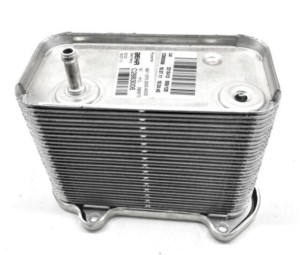 If after replacing the libation, you need to go to the next stage, having a new oil cooler is not the end of the world and at least eliminates the cooler as the source immediately.
If after replacing the libation, you need to go to the next stage, having a new oil cooler is not the end of the world and at least eliminates the cooler as the source immediately.
If replacing the cooler does not solve the problem, the remaining options are expensive and likely require major engine surgery. This is where a specialized repair shop can help to quickly and cost effectively get to the road crusade of the issue.
Coolant Piping Failure - Porsche 911 Turbo 997.1
Symptom : Initial Minor Coolant Leak Beneath Engine
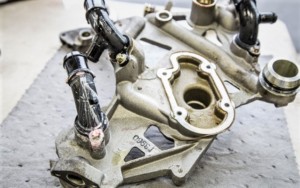 Porsche decided to fit the 997.ane Turbo engine with plastic water pipe outlets. The seals between the plastic pipe and the engine block degrade quicker than expected. As Porsche experienced on other models, plastic coolant pipes are potentially problematic.
Porsche decided to fit the 997.ane Turbo engine with plastic water pipe outlets. The seals between the plastic pipe and the engine block degrade quicker than expected. As Porsche experienced on other models, plastic coolant pipes are potentially problematic.
Replacing the seals in not a elementary job and requires specialized skills – engine removal is the preferred method. Run into our guide to independent Porsche repair shops for help.
Many owners experiencing this problem have chosen an upgrade path. This involves replacing the plastic pipes with metallic ones. This helps to forbid a recurrence of the same issue with the plastic pipes and in addition, strengthens what could be a potential weak spot for the future. Definitely a selling point for vehicles that have had the upgraded metallic pipes fitted.
Check Engine Lite and Misfire At College RPM
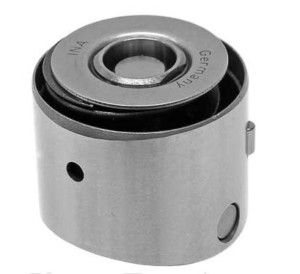 Symptoms : Engine Runs Well Up To 4K RPM Then Misfires
Symptoms : Engine Runs Well Up To 4K RPM Then Misfires
This is a problem that many so-chosen experts will tell you doesn't exist. Still, we have diagnosed and stock-still this issue on 911 and Boxster engines a number of times.
The engine runs perfectly below 3K rpm. Revving the engine in a higher place 4K rpm causes a misfire to exist reported on a unmarried cylinder and engine management shuts off the cylinder. Consequently, below 3K rpm the engine now runs crude until the mistake is cleared. Once the fault is cleared the engine runs perfectly over again below 4K until the error is triggered again.
Typically, this happens to a single cylinder repeatedly. Initially, this sounds similar a failing spark plug or curl and tin can indeed exist solved by replacing them, if you're lucky. However, if you have replaced both the coil and the plug and still have the same problem, in that location is another solution.
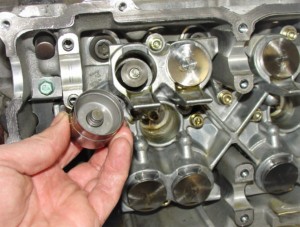 The Porsche flat 6 engine (in detail the M96) has a 2-phase intake lifter that fails. Every bit y'all advance the engine rpm, the lifter expands to increase valve lift. The lifter commonly breaks and during the 2nd phase of valve lift, which occurs higher up 4k rpm, it does not function correctly – this results in a misfire on a single cylinder. The engine management and so shuts off the cylinder until the error is cleared.
The Porsche flat 6 engine (in detail the M96) has a 2-phase intake lifter that fails. Every bit y'all advance the engine rpm, the lifter expands to increase valve lift. The lifter commonly breaks and during the 2nd phase of valve lift, which occurs higher up 4k rpm, it does not function correctly – this results in a misfire on a single cylinder. The engine management and so shuts off the cylinder until the error is cleared.
This trouble can be solved by replacing the lifters on the particular cylinder on which the fault occurs – although replacing all the lifters on that particular bank, whilst expensive, is probably the recommended solution. If left solitary, the lifter can stick causing a permanent misfire or worse.
In a couple of customer cases that we've seen, the stuck lifter went on to interruption the intake camshaft destroying the bearings in the valve cover. We likewise experienced a Boxster engine where the lifter had been ejected out of the valve encompass, leaving a nicely sized hole and very oily mess. In both these cases the engines were repaired and functioned perfectly afterwards.
Replacing lifters requires specialized skills and timing cognition – nosotros recommend you seek the assistance of an independent repair store.
Cheque Engine Light - Cam Solenoid Failure
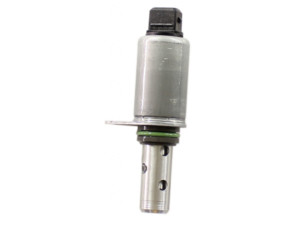 Symptoms : CEL and Lack of Power
Symptoms : CEL and Lack of Power
The M96 and M97 engines found in the 911 have variable valve lift and timing. Office of the variance is controlled past the cam solenoids located in the valve covers. The cam solenoid is an electromechnical device that redirects oil pressure equally per the demands of engine direction. The increase in oil force per unit area enables valve elevator adjustment.
Problems with these solenoids are often the crusade of a CEL and a lack of ability under acceleration. Scanning the engine management system should provide codes which identify the solenoids that are failing and replacing them unremarkably solves the problem.
Some of the cam solenoids tin can be replaced without the removal of the valve encompass; however, others do crave the valve cover removal and are more intense work. Nosotros recommend inspection of the wiring to the solenoids before replacing them – these can become corroded on older cars due to their location.
Low Mileage Storage Bug
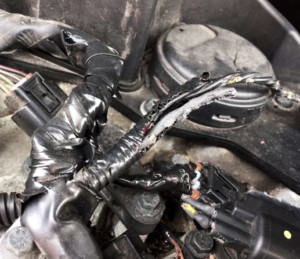 Symptoms : Unusual Electrical Behavior
Symptoms : Unusual Electrical Behavior
In some regions, such as the Midwest or Northeast, cars are often stored over the wintertime months and not driven much until all that nasty white snow stuff disappears. However, the fact that you have your car tucked away in a warm, clean and perfect garage does non mean that its is alone!
Our small rodent friends that we share this planet with, are seeking out the verbal environs yous have created for your Porsche storage. Small rodents are experts at finding a safety place and hiding beyond your view.
What Looks Good To A Rodent?
The motel air filter makes the perfect identify for a warm nest – when was the last time you looked in there? Also, the center of the engine, right below the intake, is a perfect identify for the safe consumption of food. It's supplemented by wires that are coated with a plastic made from corn and on cold, long dark wintertime nights when nutrient is in short supply, that wire seems pretty tasty. Of course, you are blissfully unaware of all of this until the automobile displays foreign engine faults and a musky aroma from the air vents!
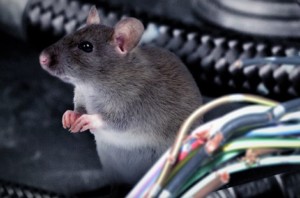 On 1 occasion, we removed a whole mouse family unit from a 911 cabriolet that had eaten the wiring harness, destroyed the carpets, (summit stored down) and had eaten most of the cabriolet top. The lady owner described crude engine running, an alarm that sounded for no reason and an odd smell while she drove it to us with the top down! The tech inspecting the car was confronted by at least 10 mice that scattered in all directions!
On 1 occasion, we removed a whole mouse family unit from a 911 cabriolet that had eaten the wiring harness, destroyed the carpets, (summit stored down) and had eaten most of the cabriolet top. The lady owner described crude engine running, an alarm that sounded for no reason and an odd smell while she drove it to us with the top down! The tech inspecting the car was confronted by at least 10 mice that scattered in all directions!
Take rodent precautions even if you are certain you don't have that problem.
Gear Shift Cable Bug - Sloppy Gear Change - Manual Transmission
Symptoms: Gear Shifter is Floppy, Inconsistent or Stuck In Gear
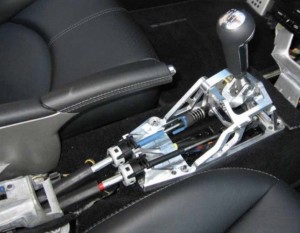 911 models fitted with a manual transmission tin often experience problems with the gear shifter mechanism.
911 models fitted with a manual transmission tin often experience problems with the gear shifter mechanism.
The gear shifter operated past the driver, is continued to the transmission past two cables. Over time these 2 cables get worn and the result is a sloppy gear change, missed gear or a manual that refuses to come out of the gear selected.
There's lots of potential for these 2 cables to have issues at either end. At the transmission end the cables can break, the pocket-size connectors on the end of the cable come off and they can degrade with exposure to the elements. At the shifter terminate, the cables can become notchy, worn or stretch.
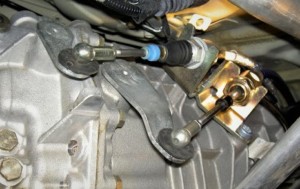 There is aligning in the cables, however the original cables have been improved and nosotros recommend replacing them. Missing a gear through a worn shifter cable is a recipe for disaster and tin lead to serious engine or manual damage.
There is aligning in the cables, however the original cables have been improved and nosotros recommend replacing them. Missing a gear through a worn shifter cable is a recipe for disaster and tin lead to serious engine or manual damage.
Upgraded versions of the cables typically produce a crisper and amend feeling gear change. The movement or throw on the 911 shifter has ever been a little long. While cable replacement work is underway, information technology's a great fourth dimension to install a short throw shifter to supplant the manufactory version.
2nd Gear Pop-Out - Manual Transmissions
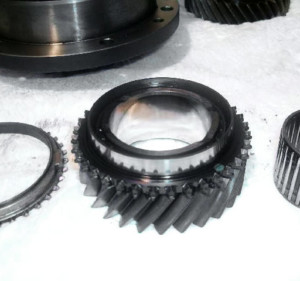 Symptoms : Gear Shift Pops Back To Neutral
Symptoms : Gear Shift Pops Back To Neutral
Several Porsche transmissions experience a '2d gear pop out event.' This is frustrating and dangerous. It can also lead to miss-shifts and engine over-revs if not addressed promptly.
A one two shift feels good until you let the clutch out and the transmission pops into neutral. It's uncomplicated to miss this and hit the gas expecting the gear to exist engaged – engine revs soar, you get nowhere and anyone else in the automobile thinks yous don't know how to drive a manual trans!
There are a couple of means to accost this issue depending upon the transmission condition. Essentially, inside the manual the op-sleeve and canis familiaris ring have been damaged. The Op-sleeve or dog ring damage occurs when the mating teeth of both parts are worn to the point where they will non engage each other or will not stay engaged afterwards a shift. This damage tin occur when the synchros wear out or when 'speed-shifting' while racing or more than commonly, when shifting while the clutch is not fully disengaged.
This problem can be solved by replacing the op-sleeve with an improved version. However, if the article of clothing is severe enough, a complete replacement of the op-sleeve and the domestic dog ring may exist necessary. In either case we always recommend the expertise and advice of the folks at GBox for manual manual repairs.
PDK Issues - Transmission Failure
Symptoms: PDK Failure Calorie-free, Rough Gear Changes, Transmission Faults, Emergency Transmission Run Warning on Dash
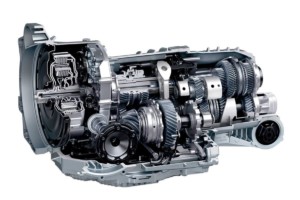 The Porsche-Doppelkupplungsgetriebe – which translates to Porsche double-clutch transmission or PDK – now that's when y'all really need an acronym! A number of Porsche 911 owners have experienced failure of the PDK manual.
The Porsche-Doppelkupplungsgetriebe – which translates to Porsche double-clutch transmission or PDK – now that's when y'all really need an acronym! A number of Porsche 911 owners have experienced failure of the PDK manual.
The PDK is an automated manual transmission. Ii units matched together – a transmission transmission rear section and automatic dual clutch front section. The manual transmission rear section is very solid and reliable. Most bug occur with the electronic and hydraulically controlled clutch section at the forepart of the transmission. Physically, the PDK is a ZF transmission unit that has been around for a number of years. VAG took multiple versions of the manual and personalized them for their various car ranges. Porsche adapted the software and labeled their version PDK.
There are a number of means in which the PDK in the 911 can neglect. Most show up as a collection of warning lights on the dash and an eventual refusal to do anything. The only viable solution for most people is the supercede the PDK – this is very expensive. Still, much of the need for replacement of the PDK comes from a lack of agreement, unavailable parts and an unwillingness to dig deep.
Components and Failures
Manual Control Module – TCM
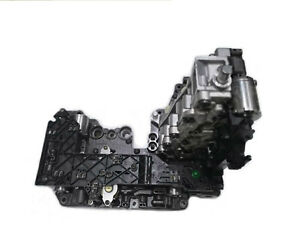 The connection to the auto and advice of instructions to the transmission, come from an external module called a transmission Control Module (TCM). While this rarely has issues, it can get confused and has been the subject of a number of software revisions. Re-flashing the TCM doesn't usually solve problems, but ensuring yous have the latest software revision can't hurt. This is where diagnostic faults are stored.
The connection to the auto and advice of instructions to the transmission, come from an external module called a transmission Control Module (TCM). While this rarely has issues, it can get confused and has been the subject of a number of software revisions. Re-flashing the TCM doesn't usually solve problems, but ensuring yous have the latest software revision can't hurt. This is where diagnostic faults are stored.
Mechatronic Unit – Valve Body
The TCM sends instruction to the Mechatronic unit or valve body inside the manual. The Mechatronic unit of measurement is a complex series of electronics, hydraulic valves and sensors. These devices are managed by a control module attached to the Mechatronic unit of measurement. This is the organisation which enables gear changes and controls the transmission functionality.
The Mechatronic unit is a common failure point for this type of transmission. In 2009, VW recalled 53000 of them – so there take been many bug in the past. Problems with the Mechatronic unit vary, but normally include failure to select gears, rough gears changes, etc. The physical components of the transmission are robust, so this unit of measurement is ofttimes the virtually economical place to kickoff for well-nigh issues.
Sensors
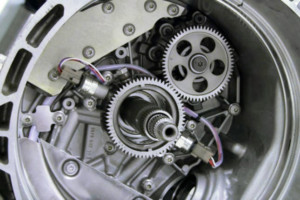 Connected to the Mechatronic unit are a number of sensors throughout the transmission. These determine the operating conditions within the manual. For example, the temperature of the fluid, the rotational output speed, hydraulic clutch pressure and movement of gears selectors. Failure of these sensors is very common. Early on, Porsche routinely replaced the wiring and trans temp sensor in nigh of the PDKs.
Connected to the Mechatronic unit are a number of sensors throughout the transmission. These determine the operating conditions within the manual. For example, the temperature of the fluid, the rotational output speed, hydraulic clutch pressure and movement of gears selectors. Failure of these sensors is very common. Early on, Porsche routinely replaced the wiring and trans temp sensor in nigh of the PDKs.
Still, the problem did not go away and has re-occurred on the aforementioned transmissions further down the road. The temp sensor problem can testify up on well-nigh whatever model with a PDK.
Clutch
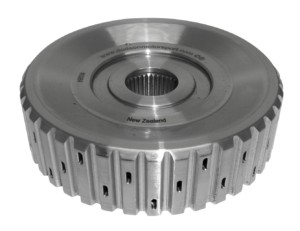 The clutch pack has proven to exist very robust and generally does non fail with normal use. Over extended mileage this will become a wear component that volition need to be replaced. The failures of the clutch that have occurred, are usually on functioning enhanced engines delivering also much torque for the clutch plates. At higher torques, the clutches sideslip resulting in highly accelerated habiliment and early failure.
The clutch pack has proven to exist very robust and generally does non fail with normal use. Over extended mileage this will become a wear component that volition need to be replaced. The failures of the clutch that have occurred, are usually on functioning enhanced engines delivering also much torque for the clutch plates. At higher torques, the clutches sideslip resulting in highly accelerated habiliment and early failure.
Why do I need to supersede the PDK?
The PDK transmissions in the afterwards cars are very circuitous and the engineering involved is a closely guarded secret. Technicians at Porsche are not trained to dissect the transmission and make repairs. They volition supersede the Mechatronic unit, merely ofttimes they just replace the transmission equally a whole. The components such as the Transmission Command Module (TCM) and the Mechatronic Unit or valve body inside the manual are often unavailable equally parts outside of the Porsche workshop.
The manufacturers exercise not want information technology taken apart and it'south often described as a "sealed PDK". The result from faults is often a new PDK, when in reality, an internal component bandy would likely save the whole unit from being replaced. While at that place is a lot of complex "stuff" in in that location, the concrete components typically don't break. So, existence forced to lash out $12K to $15K for a new PDK, in our listen, is often caused by an unwillingness of people to take the affair apart!
Can You Get Creative?
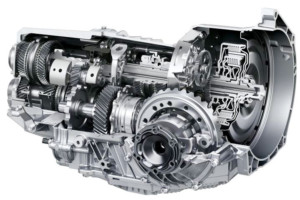 Creative can often translate to money saving. Removal and disassembly of the PDK is not complex. Notwithstanding, access to parts and the demand for a PIWIS to re-initialize the PDK are barriers for the DIY enthusiast. There is an first-class article here that provides good background, examples of the work and videos of the internals of the manual.
Creative can often translate to money saving. Removal and disassembly of the PDK is not complex. Notwithstanding, access to parts and the demand for a PIWIS to re-initialize the PDK are barriers for the DIY enthusiast. There is an first-class article here that provides good background, examples of the work and videos of the internals of the manual.
Having experienced a PDK problem on a vehicle nosotros endemic, we got creative. Based on problems with other transmissions, such as the Mercedes Benz, commonly known for valve body failure, we were convinced our issues lay in the physical function of the Mechatronic unit. Short version – we got a new Mechatronic unit of measurement from Audi, replaced the electronics with the original unit from the Porsche, flashed the TCM to match new software levels and hey presto, a perfectly working PDK!
If you lot have PDK issues and want to endeavour something artistic before shelling out for a new unit, y'all'll need the help of an practiced independent Porsche repair shop.
Exhaust Rattle and CEL for Catalytic Converter Inefficiency
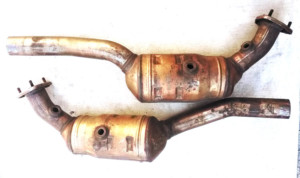 Symptoms : Exhaust Rattle Under Acceleration
Symptoms : Exhaust Rattle Under Acceleration
Many of the older 911 models are starting to experience failure of their catalytic converters and mufflers. In many cases, the main exhaust header pipe leading to the cat converter will crack and fail completely.
Initially, you lot'll start to notice a rattle dorsum there. This is caused past the muffler or the cat or both coming autonomously internally. While abrasive, it'southward likewise potentially destructive – a partial blockage in the exhaust tin can crusade the engine to non run or worse, information technology will cause immense oestrus to build at the blockage point. Seeing a catalytic converter glowing bright orange under the bumper of a 911 is quite disconcerting! This has machine fire written all over it!
The disintegration of the catalytic converter typically causes a check engine light with codes associated to converter inefficiency. This means you can't pass the emissions examination and in some states that means not driving the machine at all.
The replacement parts from Porsche fall into 2 categories – 1. ridiculously expensive or 2. non bachelor. The solution is an aftermarket exhaust that fits your budget. See our performance parts for some sensible suggestions to supervene upon the cat or muffler sections on your 911. In addition, many repair shops besides have imaginative solutions for solving these bug.
Cabriolet Top Malfunction
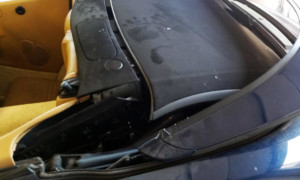 Symptoms: Height Wont Motion or is Lopsided Going Up or Down
Symptoms: Height Wont Motion or is Lopsided Going Up or Down
All of the cabriolet tops feel issues at i time or another. These vary from the degrading of the rear window to the unbalanced or lopsided opening and closing.
The window is easy – a skilful automotive upholstery or tiptop eye can replace that old, tired plastic rear window very economically.
The other bug with the height that business organisation opening and closing, usually have a unproblematic cause – beginning, the older Porsche 911 received a revised set of motors and drives to cure the nigh common issues. Usually, this means yous'll have to replace the entire drive system, as the newer versions are non compatible with the older components.
Secondly, the bushings on some of the support arms neglect over time and this causes the common lopsided effect during a endmost or opening procedure. This is a relatively cheap fix past replacing the support arm.
Diagnosing Cabriolet Height Malfunction
While the opening and closing of the top involves a number of components and can seem complex, in reality, the elevation motility is quite simple. At that place are a series of steps from the press of the button through to the completion of the process. If a step is not completed or will non operate, the height will not open up or close correctly. Merely follow each pace and make sure the footstep is functioning correctly.
A note on storage – don't store the machine with the acme down. The superlative tends to shrink and after a few years volition not stretch enough to reach the closed position. Always store the machine with the top upwardly.
Hood or Engine Lid Volition Non Stay Open
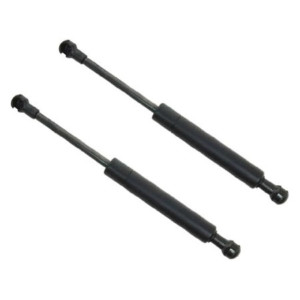 Symptoms: Lift The Lid and It Falls Downward On Your Head!
Symptoms: Lift The Lid and It Falls Downward On Your Head!
This is very mutual and very annoying for the person with their head stuck in the engine bay looking for something.
The hydraulic struts on either side of the hood or lid fail over time. This is abrasive simply besides unsafe – the latch on both the hood or the engine hat can give your head a nasty accident if it falls down unannounced.
Replacing the struts is simple and they are available online at low cost. You'll have a much better relationship with a repair store that works on your machine if you fix these!
AC System Will Not Cool
 Symptoms: Warm Air From AC or Loss of Refrigerant Over Fourth dimension
Symptoms: Warm Air From AC or Loss of Refrigerant Over Fourth dimension
If your Air-conditioning system blows warm air, the most common issue is a lack of refrigerant. Over fourth dimension the refrigerant from the AC system volition find its way out of the hoses and joints. If, yet, you refill the organization and sometime later the arrangement is again low on refrigerant, there is conspicuously a larger than normal leak.
Leaks can occur at any section joint or hose, even so, 1 of the about common and missed places for the leak is at the lower corner of the forepart condensers.
Debris from leaves and road clay can build upwards tucked in the extreme lower corner of the condensers of the 911. The debris can hold moisture and degrade the aluminum to point were a pigsty can appear. This is about impossible to see or make clean out without the bumper existence removed.
The refrigerant leak often goes undetected even to a sniffer without the droppings being cleaned away. Check this thoroughly before making any other assumptions. The AC compressor for instance, rarely has issues and a depression refrigerant state of affairs can preclude the compressor from engaging.
Unusual Electric Behavior - Windows Not Aligned on Cabriolet
Symptoms : Various Electric Systems Disabled
If your battery has gone flat or required a change, you lot may feel some of these bug.
On some models, swapping out the battery tin crusade the machine to become into "delivery mode." This is the manner used for aircraft the car from Germany. Delivery mode ensures that sure electrical systems similar seat warmers, windows, home link, and college driving speeds are disabled. To complete the installation of a new battery you need a Porsche diagnostic device to "deliver" the machine or complete a "handover" into normal mode.
Loss of battery power on cabriolet models can crusade the windows to get out of step with the doors. Opening the doors should lower the windows slightly, to enable easy access. Power failure tin can cause this function to get abroad and enable the re-learning of the window position function. Again, this requires a reset via the handover office using a Porsche diagnostic organization.
Cabriolet Windows Out of Step With Door Open up
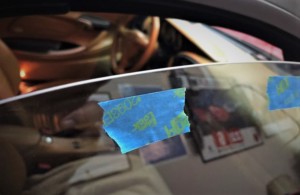 If the windows on a cabriolet model become out of stride with the door opening condition and no loss of power has occurred, then another issue is the likely crusade. Typically, this problem is caused by the activation of the door handle not being seen by the window mechanism.
If the windows on a cabriolet model become out of stride with the door opening condition and no loss of power has occurred, then another issue is the likely crusade. Typically, this problem is caused by the activation of the door handle not being seen by the window mechanism.
There are a number of potential means this can fail and it is necessary to follow a process to isolate the cause. Go through the functionality of the door and window in question from locking to unlocking, from open to close from both inside and out. Unremarkably, this volition result in narrowing down the problem to a micro switch in the door handle or lock mechanism.
- Window does not drib when opening the door from the inside: This is usually caused by the inner door handle micro switch malfunctioning.
- Window does not drib when opening the door from the exterior: This is usually acquired past the outer door handle micro switch malfunctioning.
- With the door open, the window goes dorsum upwardly when you release the door handle, making information technology very hard to close the door with the glass all the way up. Alternatively, the window does not drop when using either the within or outside door handle: This is usually acquired by the door latch mechanism micro switch.
- When operating the convertible superlative, neither windows drop: This is usually caused by the convertible height latch micro switch.
- If a window does non drop enough and you lot can button down the window the extra travel before stopping, the typical cause is the window regulator.
Other Interior Electric Misbehavior
On occasion, 911 models volition exhibit strange and seemingly random electric misbehavior of interior systems. This could exist interior lights staying on, air purse faults, seat malfunctions, etc. Frequently this can exist traced back to a single control module. Porsche placed the module that controls interior settings under the drivers seat.
Due to the location and proximity to the commuter door and window, this module can sometimes go water damaged – especially on cabriolet models. Once the module has got wet, it will ofttimes accept time to slowly corrode and produce strange electrical faults or misbehavior.
If you left the acme down in a shower, had the driver window open when it was raining or live in a climate where significant rain could enter when the driver door is open up, you are a good candidate to have this problem.
Ignition Switch Failure
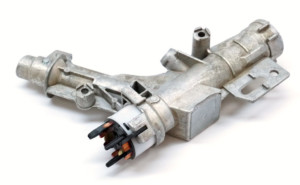 Symptoms: Cardinal Stuck in Ignition or No Start
Symptoms: Cardinal Stuck in Ignition or No Start
This is a common failure on the older 911. Turning the key volition non starting time the machine or the key has become stuck in the ignition switch.
This problem is typically caused by a failure in the ignition switch mechanism. Replacing the electrical portion of the switch is fairly straight forward and typically solves the no start problem immediately.
Notwithstanding, on some occasions it may be necessary to supersede the mechanical portion of the switch every bit well. This is a little more involved and requires some additional skills. Nosotros'd recommend a repair shop tackle this trouble for you.
Primal Failure
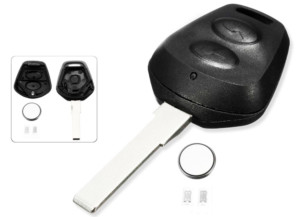 The ignition primal communicates with the car during the starting procedure. The key includes a small electronic transmitting device that is matched to the motorcar and a battery to ability it. If the key fails to open up or lock doors and will not commencement the car, replace the bombardment in the primal first, paying item attention to the orientation of the original battery.
The ignition primal communicates with the car during the starting procedure. The key includes a small electronic transmitting device that is matched to the motorcar and a battery to ability it. If the key fails to open up or lock doors and will not commencement the car, replace the bombardment in the primal first, paying item attention to the orientation of the original battery.
On some occasion it may be necessary to replace the internal electronics of the central or the whole key itself. This can exist done by some third political party repair shops with the correct access to Porsche systems, all the same, considering this is a security device information technology may be necessary to visit your local dealer.
Rear Spoiler Malfunction
Symptoms: Rear Spoiler Lopsided or "Failure Spoiler Control" on Dash
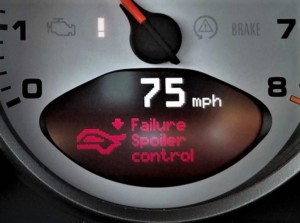 It's very cool to take a spoiler that raises and lowers based on speed, however, failure of this organization can be expensive. If you feel a lopsided spoiler or one that 1 volition not raise or lower accompanied by a message on the nuance indicating a failure of spoiler control, then you lot enter the globe of rear spoiler failure.
It's very cool to take a spoiler that raises and lowers based on speed, however, failure of this organization can be expensive. If you feel a lopsided spoiler or one that 1 volition not raise or lower accompanied by a message on the nuance indicating a failure of spoiler control, then you lot enter the globe of rear spoiler failure.
Ordinarily, the hydraulic actuators for the rear spoiler will fail causing the lopsided or failure to raise faults. This is very common on the turbo models. There are a number of possible causes for this issue but the most common is a failure of the hydraulic rams that raise and lower the spoiler.
At that place are some repair kits on the market and while Porsche says the system is not serviceable, many good shops have found ways effectually that to save yous coin.
Replacement of the parts can be expensive and time consuming, and typically the repairs are non lifetime. The same issues will reoccur at some bespeak in the hereafter unless the hydraulics are replaced with a third party electric ram designed to eliminate the original design flaws. You can observe our favorite replacement hither.
Faulty Change Over Valve (COV) Solenoids
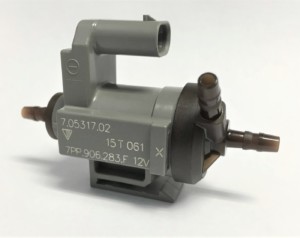 Symptoms: Frazzle Flap Failure or Heater Shut Off, etc.
Symptoms: Frazzle Flap Failure or Heater Shut Off, etc.
The vacuum solenoid or alter over valve has been an effect on all the 911 chassis.
The device is designed to direct engine vacuum to effect a mechanical change when requested to past an electric control unit e.yard. open a vent, change the position of an exhaust flap, redirect hot air from feet to screen etc. Likely systems effected include:
1. Air Cleaner Flap
ii. Acoustic Simulator
3. Heater Shut-Off Valve
4. Frazzle Flaps
v. Coolant Shut-Off Valve on Engine Bypass Circuit
six. Tuning Flaps
7. Shut-Off Valve on Heat Exchanger for Gear Bike Set up Oil
viii. Shut-Off Valve for Clutch Fluid Estrus Exchanger (PDK Merely)
9. Fuel Tank Vent Valve
Porsche has used the COV in many circumstances throughout the 911 chassis, so if you have a failure related to a mechanical device controlled by vacuum, look for a failure in the COV solenoid in the system first.
About recently, the 991 cars have had all of their COV solenoids replaced in a maintenance campaign.
Oil Level High or Low - Topping Off Oil Level
Symptoms: Warning Bulletin Oil Level Too Low or High
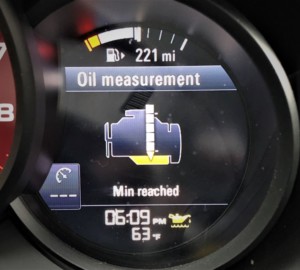 If you experience an oil level as well high or also low message, exist careful. First, there is no dipstick – brilliant thought most of the German car manufacturers have implemented. The oil level is measured electronically for accuracy. This is awesome, assuming the electronic measurement is accurate or is at the very least telling yous the truth. There is no transmission backup of the tried and trusted dipstick – so did you overfill or nether fill? Or do you have a faulty sensor?
If you experience an oil level as well high or also low message, exist careful. First, there is no dipstick – brilliant thought most of the German car manufacturers have implemented. The oil level is measured electronically for accuracy. This is awesome, assuming the electronic measurement is accurate or is at the very least telling yous the truth. There is no transmission backup of the tried and trusted dipstick – so did you overfill or nether fill? Or do you have a faulty sensor?
You have to be certain of which one before you take action. The only manner to be certain is confirm the amount of oil in the engine by draining and measuring. We've experienced an oil reading that went down when nosotros added a quart! Don't exist surprised if the oil level sensor is not telling the truth but, make sure you are certain that the oil level is correct before ignoring the sensor and replacing it.
Oil Level Peak Off
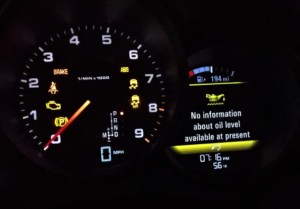 The Porsche engines will naturally eat oil while y'all drive. Different driving styles and weather condition will cause oil consumption to change. With the extended mileage between oil changes that manufacturers have opted for, it's very likely the car volition call for additional oil betwixt scheduled service intervals. Most independent shops consider the extended mileage range between oil changes too extreme and just a marketing gimmick.
The Porsche engines will naturally eat oil while y'all drive. Different driving styles and weather condition will cause oil consumption to change. With the extended mileage between oil changes that manufacturers have opted for, it's very likely the car volition call for additional oil betwixt scheduled service intervals. Most independent shops consider the extended mileage range between oil changes too extreme and just a marketing gimmick.
If your 911 calls for boosted oil, here's what to do:
- Ideally, the engine should be at operating temperature
- The deviation between the minimum and maximum reading is approx. 1 quart
- Practise not add more than 1 quart at a time
- Remeasure the oil level later each quart added
- After calculation a quart, drive the automobile for 5 to x mins earlier rechecking the level
- Oil reading is non instant and requires a bulldoze bicycle
Notwithstanding Tin't Find An Answer? – Contact Us For More Help
If your 911 has mechanical issues that don't appear here, simply driblet us an email via the forms or popular-upward contact and we'll exercise our best to share a solution with you.
colemanduerse1972.blogspot.com
Source: https://www.pcarwise.com/local-help/porsche-common-problems/porsche-911-common-problems/
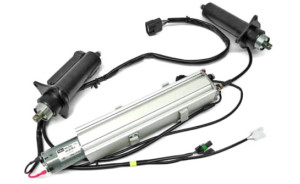
Post a Comment for "2000 Porsche 996 911 Evomsit Software Upgrade Reviews"